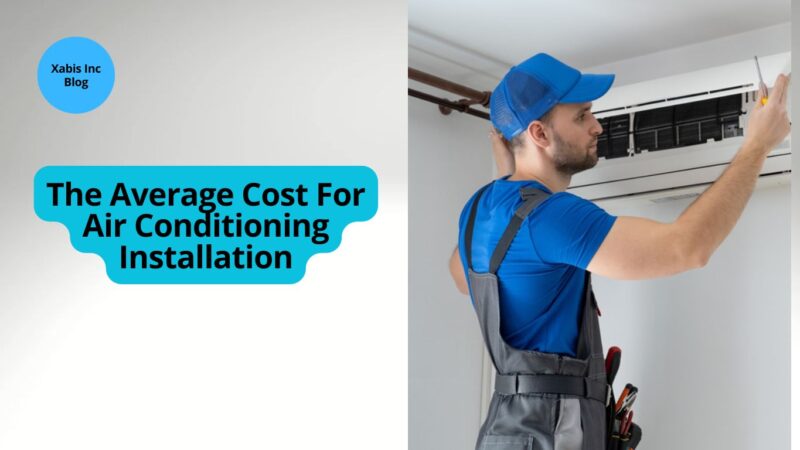A reliable air conditioning system is necessary to keep your home cool and comfortable. Understanding the average cost for air conditioning installation can help you make informed decisions.
This article will break down the primary factors influencing the cost of AC installation, allowing you to anticipate the expenses better.
1. Type Of Air Conditioning System
Another crucial factor to consider is the choice of contractor, as their expertise and reputation can significantly impact the overall cost and quality of the installation. It’s essential to research and select a reputable contractor who offers transparent pricing and reliable service. For those looking to explore more about the installation process and associated costs, click for details to gain further insights. This can help homeowners make informed decisions and ensure they receive the best value for their investment. Additionally, understanding the warranty options and post-installation support offered by the contractor can provide peace of mind and long-term savings.
The type of air conditioning system you choose is one of the most significant factors influencing the installation cost. There are several options available, including:
- Central Air Conditioning: This is the most common type suitable for cooling the entire house. It typically costs more to install because it requires ductwork.
- Ductless Mini-Split Systems: These are great for cooling individual rooms and don’t require ductwork, making installation less labor-intensive and sometimes cheaper.
- Window Units: Ideal for single rooms, these are the least expensive options for installation.
- Portable Units: Though easy to set up, portable units are usually not as efficient, and the cost mainly includes purchasing the unit itself.
Each type of system varies significantly in price and installation complexity, which impacts the overall cost.
2. Size And Capacity Of The Unit
The size and capacity of the AC unit also play a critical role in determining installation costs. An undersized unit will struggle to cool the space, while an oversized unit will cycle on and off too frequently, leading to inefficiency and potential damage over time.
Thus, it’s important to choose the right size based on the square footage of your home.
- Small Units (1.5 to 2 tons): Generally cost less but are suited only for smaller spaces.
- Medium Units (2.5 to 3.5 tons): Perfect for mid-sized homes and priced mid-range.
- Large Units (4 to 5 tons): These units are the most expensive and designed for large homes.
A professional HVAC technician can help calculate the appropriate size by checking room size, ceiling height, insulation quality, and the number of windows.

3. Complexity Of The Installation
The complexity of the installation process will significantly affect the overall cost. Here are a few aspects to consider:
- Ductwork Requirements: Installing a central AC system in a home without ductwork will cost substantially more due to the labor and materials involved.
- Electrical Modifications: Sometimes, older homes need electrical upgrades to support a modern AC system, adding to the expense.
- System Location: Placing the unit in an accessible spot is less costly than installing it in hard-to-reach areas like attics or crawl spaces.
- Permits and Regulations: Some localities require specific permits or adherence to building codes, which can lead to extra fees.
If the air conditioning unit installation is straightforward, you’ll save on labor costs. However, any additional work required to prepare the home for the system will drive up the price.
4. Brand And Efficiency Of The Unit
The unit’s brand and energy efficiency rating will also impact the cost. Some reputable brands are known for their durability and advanced features but have a higher price tag.
- Standard Brands: These are generally more affordable but may lack certain features.
- Premium Brands: They offer superior build quality with advanced technology and often come with better warranties.
- Energy Efficiency: Units with high SEER ratings are initially more expensive but save money on energy bills over time.
Choosing a high-efficiency unit is a long-term investment, but it’s important to balance the cost with your immediate budget constraints.
5. Labor Costs And Contractor Rates
Labor costs vary widely depending on your location and the contractor’s expertise. HVAC professionals may charge more in some areas due to higher living costs or increased demand.
Always obtain multiple quotes to find a reliable contractor with reasonable rates when considering labor costs.
Some contractors also offer package deals that include both the unit and the installation. While this may be cost-effective, ensure that you don’t compromise on quality or service.
6. Additional Features And Accessories
Optional add-ons and features can add to the total cost of installation. These include:
- Smart Thermostats: A programmable or smart thermostat can optimize your system’s performance but comes at an additional cost.
- Air Purifiers or Dehumidifiers: These accessories improve air quality and comfort while increasing prices.
- Zoning Systems: Zoning allows you to control the temperature of different rooms independently, adding convenience and cost.
While these features enhance comfort and energy efficiency, they can significantly raise the overall expense of air conditioning installation.
Conclusion
The cost of installing an air conditioning system can vary significantly based on several key elements, including the type and size of the unit, installation complexity, brand, and labor rates.
Understanding these factors can help you better plan your budget and choose the right system for your home. Always consult a licensed HVAC professional to get an accurate estimate tailored to your needs.
Proper planning and informed decisions will ensure a smooth installation process and long-term comfort for your home.
For top-notch air conditioning services, choose True North Air Conditioning. Our experienced team is committed to providing reliable installations and exceptional customer service.
Contact us today for all your air conditioning needs and experience the change firsthand!







